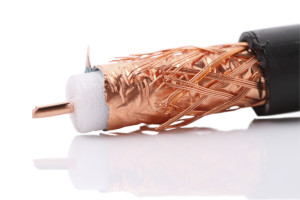Coaxial Cable
Galaxy is a leading supplier of coaxial cable.
Coaxial Cable Technical Specifications
The following is a sample of the coaxial cable Galaxy offers in the following ranges of technical specifications:
| Cable Type | Mil Designation | Impedance | Dielectric | NOM OD (IN) | Shield |
|---|---|---|---|---|---|
| RG-6 | M17/2-RG6 | 75 | PE | 0.332 | BRAID |
| RG-8 | 52 | PE | 0.405 | BRAID | |
| RG-9 | 51 | PE | 0.42 | BRAID | |
| RG-11 | M17/6-RG11 | 75 | PE | 0.405 | BRAID |
| RG-58 | M17/28-RG58 | 52 | PE | 0.195 | BRAID |
| RG-59 | M17/29-RG59 | 75 | PE | 0.242 | BRAID |
| RG-62 | M17/30-RG62 | 93 | ASP | 0.242 | BRAID |
| RG-122 | M17/54-RG122 | 50 | PE | 0.16 | BRAID |
| RG-133 | M17/100-RG133 | 95 | PE | 0.405 | BRAID |
| RG-142 | M17/60-RG142 | 50 | PTFE | 0.195 | BRAID |
| RG-178 | M17/93-RG178 | 50 | PTFE | 0.072 | BRAID |
| RG-179 | M17/94-RG179 | 70 | PTFE | 0.1 | BRAID |
| RG-180 | M17/95-RG180 | 93 | PTFE | 0.14 | BRAID |
| RG-195 | 95 | PTFE | 0.145 | BRAID | |
| RG-213 | M17/74-RG213 | 50 | PE | 0.405 | BRAID |
| RG-214 | M17/75-RG214 | 50 | PE | 0.425 | BRAID |
| RG-223 | M17/84-RG223 | 50 | PE | 0.211 | DB BRAID |
| RG-302 | M17/110-RG302 | 75 | PTFE | 0.201 | BRAID |
| RG-303 | M17/111-RG303 | 50 | PTFE | 0.17 | BRAID |
| RG-304 | M17/112-RG304 | 50 | PTFE | 0.28 | BRAID |
| RG-316 | M17/113-RG315 | 50 | PTFE | 0.1 | BRAID |
| RG-391 | M17/126-RG391 | 72 | NA | 0.405 | BRAID |
| RG-392 | M17/126-RG392 | 72 | NA | 0.475 | BRAID |
| RG-393 | M17/127-RG393 | 50 | PTFE | 0.39 | BRAID |
| RG-400 | M17/128-RG400 | 50 | PTFE | 0.195 | DB BRAID |
| RG-401 | M17/129-RG401 | 50 | PTFE | 0.25 | BRAID |
| RG-402 | M17/130-RG402 | 50 | PTFE | 0.141 | BRAID |
| RG-403 | M17/131-RG403 | 50 | PTFE | 0.118 | DB BRAID |
| RG-404 | M17/132-RG404 | 50 | PTFE | 0.073 | BRAID |
| RG-405 | M17/133-RG405 | 50 | PTFE | 0.086 | BRAID |
Terminology Notes
There are various terms used in the wire and cable industry related to this type of cable. They include:
- Ohm – The ohm is defined as a resistance between two points of a conductor when a constant potential difference of 1.0 volt, applied to these points, produces in the conductor a current of 1.0ampere, the conductor not being the seat of any electromotive force.
- Impedance – the ratio of the voltage phasor to the electric current phasor, a measure of the opposition to time-varying electric current in an electric circuit.
- Dielectric – insulator material used in coaxial cables.
- Capacitance – The capacitance of a coaxial line varies with the spacing of the conductors, the dielectric constant, and as a result the impedance of the line.
- VSWR – Voltage Standing Wave Ratio is a function of the reflection coefficient, which describes the signal reflected back from a connector.
- Attenuation – is a reduction of signal strength during transmission.
*Tefzel® is a registered trademarks of E. I. du Pont de Nemours and Company.
Contact Galaxy Wire & Cable for Coaxial Cable
Contact Galaxy for further assistance with coaxial cables.

 Galaxy is a leading supplier of coaxial cable. Coaxial cables, or RF cables, are typically used in applications when transferring radio frequencies are necessary. Coaxial or RF cables are used in a wide range of applications including broadband CATV, telecommunications, antennae, video, data control and instrumentation.
Galaxy is a leading supplier of coaxial cable. Coaxial cables, or RF cables, are typically used in applications when transferring radio frequencies are necessary. Coaxial or RF cables are used in a wide range of applications including broadband CATV, telecommunications, antennae, video, data control and instrumentation.